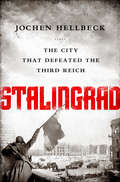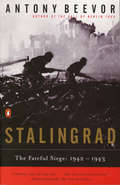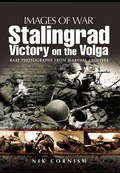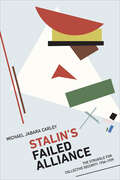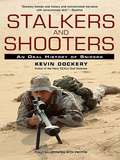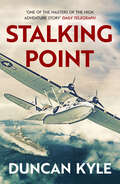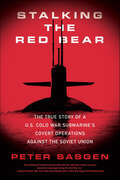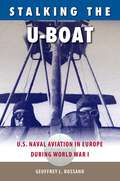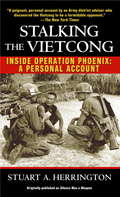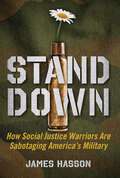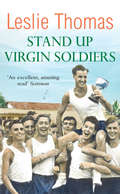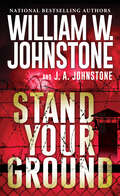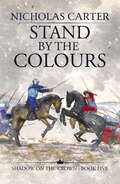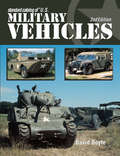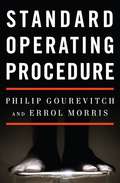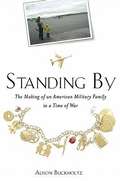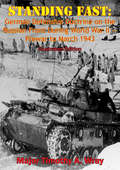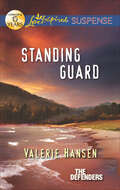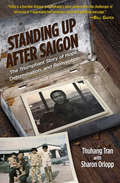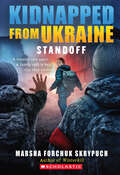- Table View
- List View
Stalingrad: The City that Defeated the Third Reich
by Jochen Hellbeck Translated by Christopher Tauchen Dominic BonfiglioJust days after the Germans surrendered at Stalingrad, legendary Red Army sniper Vasily Zaytsev described the horrors he witnessed during the five-month long conflict: "one sees the young girls, the children who hang from trees in the park. . . I have unsteady nerves and I'm constantly shaking. ” He was being interviewed, along with 214 other men and women--soldiers, officers, civilians, administrative staffers and others--amidst the rubble that remained of Stalingrad by members of Moscow’s Historical Commission. Sent by the Kremlin, their aim was to record a comprehensive, historical documentary of the tremendous hardships overcome and heroic triumphs achieved during the battle. 20 soldiers of the 38th Rifle Division vividly recount how they stumbled upon the commander of the German troops, Field Marshal Friederich Paulus, defeated and hiding in a bed that reeked like a latrine. A lieutenant colonel remembers the brave 20 year-old adjutant who wrapped his arms around his commander’s body to protect him from a flying grenade. Working around the clock, Nurse Vera Gurova describes a 24 hour period during which her hospital received over than 600 wounded men - equivalent to one every two and an half minutes. Countless soldiers endured shrapnel wounds and received blood transfusions in the trenches, but she can’t forget the young amputee who begged her to avenge his suffering at Stalingrad. This harrowing montage of distinct voices was so candid that the Kremlin forbade its publication and consigned the bulk of these documents to a Moscow archive where they remained forgotten for decades, until now. Jochen Hellbeck’s Stalingrad is a definitive portrait of perhaps the greatest urban battle of the Second World War--a pivotal moment in the course of the war re-created with absolute candor and chilling veracity by the voices of the men and women who fought there.
Stalingrad: The Fateful Siege: 1942-1943
by Antony BeevorThe Battle of Stalingrad was not only the psychological turning point of World War II: it also changed the face of modern warfareBeevor's latest book Ardennes 1944: The Battle of the Bulge is now available from Viking Books Historians and reviewers worldwide have hailed Antony Beevor's magisterial Stalingrad as the definitive account of World War II's most harrowing battle.In August 1942, Hitler's huge Sixth Army reached the city that bore Stalin's name. In the five-month siege that followed, the Russians fought to hold Stalingrad at any cost; then, in an astonishing reversal, encircled and trapped their Nazi enemy. This battle for the ruins of a city cost more than a million lives. Stalingrad conveys the experience of soldiers on both sides, fighting in inhuman conditions, and of civilians trapped on an urban battlefield. Antony Beevor has itnerviewed survivors and discovered completely new material in a wide range of German and Soviet archives, including prisoner interrogations and reports of desertions and executions. As a story of cruelty, courage, and human suffering, Stalingrad is unprecedented and unforgettable.From the Trade Paperback edition.
Stalingrad: Victory On The Volga (Images Of War Ser.)
by Nik CornishThe Soviet victory over the Germans at Stalingrad was decisive for the war on the Eastern Front and for the Second World War as a whole, and the story of the long, bitter battle on the banks of the Volga has fascinated historians ever since. While it has been the subject of countless histories, memoirs and eyewitness accounts, the grueling reality of the battle on the ground, in the shattered streets and buildings of the city, has rarely been recorded photographically.The great strength of Nik Cornish's selection of unforgettable images is in its scale. He documents every aspect of the fighting - the dreadful conditions endured by the soldiers, the jagged outline of the ruined city, the harrowing daily routine of street fighting and close-quarter combat, the casualties and the dead, and the battle behind the lines - the tremendous effort made by the Germans and the Soviets to sustain their men in what had become a fight to the death. But perhaps most memorable of all, the photographs give us glimpses of the lives and deaths of soldiers on both sides who participated in one of the most terrible battles in history.
Stalinism and the Soviet-Finnish War, 1939–40: Crisis Management, Censorship and Control (St Antony's Series)
by Malcolm L. SpencerThis book offers an illuminating bridge between the political and social dimensions of the Soviet-Finnish War of 1939-40. The conflict represented a significant crisis for the Soviet Union, inspiring international condemnation and a significant loss of face for its supporters, both at home and abroad. The focus of this study is not upon the military dynamics of the war, but upon its ability to influence events, interpretations and interactions between agents and institutions within the Soviet Union and the wider international communist movement. Through original archival research, this book considers the ways in which the Soviet leadership reacted to the crisis, the tools at its disposal, and the effectiveness with which it managed to manipulate and control the spread of information through official and unofficial channels. It contributes to a more complete and complex picture of the inter-related nature of Soviet politics, propaganda and mass media in this period.
Stalin’s Failed Alliance: The Struggle for Collective Security, 1936–1939
by Michael Jabara CarleyIn the spring of 1936, the Soviet effort to build an anti-Nazi alliance was failing. Stalin continued nevertheless to support diplomatic efforts to stop Nazi aggression in Europe. In Stalin’s Failed Alliance, the sequel to Stalin’s Gamble, Michael Jabara Carley continues his re-evaluation of European diplomacy during the critical events between May 1936 and August 1939. This narrative history examines the great crises of the pre-war period – the Spanish Civil War, Anschluss, and Munich accords – as well as both the last Soviet efforts to organize an anti-Nazi alliance in the spring–summer of 1939 and Moscow’s shocking volte-face, the signing of the Nazi-Soviet non-aggression pact. Carley’s history traces the lead-up to the outbreak of war in Europe on 1 September 1939 and sheds light on the Soviet Union’s efforts to organize a defensive alliance against Nazi Germany, in effect rebuilding the anti-German Entente of the First World War. The author argues for the sincerity of Soviet overtures to the western European powers and that the non-aggression pact was a last-ditch response to the refusal of other states, especially Britain and France, to conclude an alliance with the USSR against Nazi Germany. Drawing on extensive archival research in Soviet and Western archival papers, Stalin’s Failed Alliance aims to see the European crisis of the 1930s through Soviet eyes.
Stalkers and Shooters: A History of Snipers
by Kevin DockeryNow in paperback! From the author of the Navy SEALs Oral History series-an intimate look at the world's most efficient and deadly warriors. Snipers have a rich history. This fascinating book follows their tasks and techniques from the Revolutionary and Civil Wars through both World Wars, to the Korean War and Vietnam-the genesis of modern sniping-to the current conflicts in the Middle East. Also, readers will see how sniping has evolved on the civilian side in law enforcement. Readers will learn about the tools of the trade, but most importantly, they will hear from the experts themselves: military snipers, as well as civilian police and SWAT snipers. Capturing the suspense and action of the hunt, the words of these men draw readers into the close-knit, little-known world of men who need only one bullet to get the job done.
Stalking Point (Duncan Kyle Collection)
by Duncan KyleA covert game of cat and mouse will decide the victor of the Second World War.1941. The battleship Prince of Wales races across the war-darkened Atlantic. Her secret human cargo makes her an irresistible prize for U-Boats. And the man she carries can, singlehanded, win or lose the war for Britain.But the most lethal threat comes from the air. For on the far side of the ocean three men are waiting for their brief to strike a deathblow for Germany.As the battleship nears its destination, a seaplane roars into life, and the deadly game begins in earnest…A vintage and enthralling WWII thriller from a master of the genre, this is top-rate historical fiction, perfect for fans of Max Hennessy, Alistair MacLean and Nevil Shute.Praise for Duncan Kyle‘One of the modern masters of the high adventure story’ Daily Telegraph‘The outstanding thriller-writer discovery of the seventies’ Evening News‘The impact couldn’t be greater’ Daily Mirror
Stalking the Red Bear: The True Story of a U.S. Cold War Submarine's Covert Operations Against the Soviet Union
by Peter SasgenThrilling submarine espionage and an inside look at the U.S. Navy's "silent service" Stalking the Red Bear, for the first time ever, describes the action principally from the perspective of a commanding officer of a nuclear submarine during the Cold War -- the one man aboard a sub who makes the critical decisions -- taking readers closer to the Soviet target than any work on submarine espionage has ever done before. This is the untold story of a covert submarine espionage operation against the Soviet Union during the Cold War as experienced by the Commanding Officer of an active submarine. Few individuals outside the intelligence and submarine communities knew anything about these top-secret missions. Cloaking itself in virtual invisibility to avoid detection, the USS Blackfin went sub vs. sub deep within Soviet-controlled waters north of the Arctic Circle, where the risks were extraordinarily high and anything could happen. Readers will know what it was like to carry out a covert mission aboard a nuke and experience the sights, sounds, and dangers unique to submarining.
Stalking the U-Boat: U.S. Naval Aviation in Europe during World War I
by Geoffrey L. Rossano"An exceptional piece of scholarship. Rossano clearly points out that military organizations in general, and a naval air force in particular, are built from the ground up and not the other way around. While we celebrate the exploits of the pilots, Rossano reminds us that there were myriad mechanics, constructors, paymasters, and even some ship drivers who played a vital role in naval aviation during WWI."--Craig C. Felker, U.S. Naval Academy "A fine book that will stand for many years as the definitive study of U.S. naval aviation in Europe. Well-researched and written, the book ranges widely, from the high-level planning in Washington for a naval air war to moving thousands of men and hundreds of aircraft across the ocean to the routine but dangerous training, patrol, and bombing flights that constituted the navy’s air mission in World War I."--William F. Trimble, author of Attack from the Sea Stalking the U-Boatis the first and only comprehensive study of U.S. naval aviation operations in Europe during WWI. The navy's experiences in this conflict laid the foundations for the later emergence of aviation as a crucial--sometimes dominant--element of fleet operations, yet those origins have been previously poorly understood and documented.Begun as antisubmarine operations, naval aviation posed enormous logistical, administrative, personnel, and operational problems. How the USN developed this capability--on foreign soil in the midst of desperate conflict--makes a fascinating tale sure to appeal to all military and naval historians.
Stalking the Vietcong
by Stuart HerringtonIn a gripping memoir that reads like a spy novel, one man recounts his personal experience with Operation Phoenix, the program created to destroy the Vietcong's shadow government, which thrived in the rural communities of South Vietnam.Stuart A. Herrington was an American intelligence advisor assigned to root out the enemy in the Hau Nghia province. His two-year mission to capture or kill Communist agents operating there was made all the more difficult by local officials who were reluctant to cooperate, villagers who were too scared to talk, and VC who would not go down without a fight. Herrington developed an unexpected but intense identification with the villagers in his jurisdiction-and learned the hard way that experiencing war was profoundly different from philosophizing about it in a seminar room.
Stand By for Action: The Memoirs of a Small Ship Commander in World War II
by William DonaldA naval memoir of the Second World War by a sea-officer who was awarded a DSC for providing anti-aircraft defense along the Norwegian coast. The author of this compelling memoir proved himself one of the most successful small ship commanders during the Norwegian campaign in 1940, and then served at sea continuously throughout the rest of the War. In Norway, as second-in-command of a Black Swan sloop, he experienced the suspense and nervous strain of operating in the narrow waters of a twisting fjord under heavy air attack, but his humor was never far away. &“I don&’t want to appear fussy, but are we going to be greeted by cheers and kisses from Norwegian blondes, or a hail of gunfire from invisible Huns?&” he remarked to his officers on approaching the small town of Andalsnes. His next task—in command first of a corvette and then a destroyer—was escorting East Coast convoys, and his experiences reflect the danger of this work against the menaces of E-boats, enemy aircraft and mines. He then took part in the landings at Anzio and the Normandy landings in 1944; finally, he rescued internees from the Japanese prison camp on Stanley, Hong Kong. His career was much helped by his highly developed sixth sense for danger, the deep affection of his crews and his affinity with cats which he believed brought him luck. This record of varied and almost incessant action ranks among the most thrilling personal stories of the war at sea.
Stand Down
by Don PendletonA Mexican drug lord has taken control of the small town of Quincyville, Kansas, and the local police are on the organization's payroll. With the life of a young woman at stake, Mack Bolan decides it's time to shut down the meth lab and clean up the town for good. Original.
Stand Down: How Social Justice Warriors Are Sabotaging America's Military
by James Hasson"James is a terrific reporter, and this account of the effort to shape our military to reflect left-wing social values rather than the priorities of readiness and capability is vital." —BEN SHAPIRO, bestselling author of The Right Side of History and host of The Ben Shapiro Show "Stand Down is a must-read for anyone who wants to understand how progressives have forced radical changes on our military—no matter how much harm it does to combat readiness." — MOLLIE HEMINGWAY, bestselling coauthor of Justice on Trial "Stand Down exposes one of the greatest but least-discussed scandals of our era. Time and time again, the Obama administration undermined the military to advance left-wing political goals — and Hasson brings the goods to prove it. Every patriotic American who cares about the military needs to read this book." — BUCK SEXTON, Former CIA Counterterrorism Officer, Host of The Buck Sexton Show "James Hasson makes a powerful and convincing case in this exceptionally well-written book. Stand Down is a scathing indictment of the Obama administration’s misuse of the military as a vehicle for progressive social change at the expense of men and women in uniform." —SEAN PARNELL, Army combat veteran and New York Times bestselling author of Outlaw Platoon “Safe space” stickers on office doors at the Naval Academy. Officers apologizing for “microaggressions” against Air Force cadets. An Army “gender integration study” urging an end to “hyper-masculinity” in combat-arms units. Power Point presentations teaching commanders about “male pregnancy.” A cover-up, as senior officials placed their thumbs on the scales to ensure the success of the first female candidates at the Army’s legendary Ranger School. These are just a few of the examples documented in this explosive book, Stand Down: How Social Justice Warriors are Sabotaging the U.S. Military by former Army Captain, Afghanistan veteran, and attorney James Hasson. Hasson exposes the relentless campaign by powerful Obama administration ideologues to remake the culture and policies of the U.S. military, even over the explicit objections of military leaders. He presents evidence—drawn from government documents and exclusive interviews with more than forty sources, including high-ranking officers and Pentagon insiders—that progressive activists in the Obama Administration used the U.S. Military as their preferred vehicle to advance the progressive agenda. The stories paint a troubling picture of what happens when leftwing political operatives impose a political agenda on our nation’s military: they render our forces less effective, place our military men and women in greater danger, and compromise the military’s sole objective: to protect America by winning the nation’s wars. “Military readiness” is a term politicians and pundits often use in the abstract to describe our military’s ability to defeat its adversaries. But it ultimately describes how well we have prepared and equipped a young soldier or sailor to prevail over an enemy determined to do them harm. Hasson makes a compelling case that our nation has a moral obligation to ensure that the sons and daughters it sends to war have the best possible chance of victory—which means we must embrace only the policies that help us win wars and reject those that don’t. Political agendas of any kind invite corruption, jeopardize lives, and undermine the mission. They have no place in military policy—a principle that the Obama administration either disdained or failed to understand.
Stand Up Virgin Soldiers
by Leslie ThomasThe worst has happened. On the eve of their return to Blighty, Brigg and his fellow National Servicemen find themselves sentenced to another six months in Panglin Barracks...Many of the surviving characters from The Virgin Soldiers live again in these pages: dogged Tasker, the odious Sergeant Wellbeloved, the vulnerable Colonel Bromley Pickering and the comically touching Juicy Lucy.But we encounter new characters too: the fanatical and demented Lieutenant Grainger; the endearing Welshman, Morris Morris - strong as a horse but bafflingly buxom; US Private Clay - mysteriously lost in transit by the American Army; and last, but not least, Bernice Harrison, the sporting nurse who threatens to replace the wayward Lucy in Brigg's affections...
Stand Your Ground
by William W. Johnstone J.A. JohnstoneAn explosive thriller in which an Army Ranger battles it out in Texas to fight for the red, white, and blue is repackage with a bold new cover for new and old fans of national bestselling authors William W. and J. A. Johnstone.FREEDOM IS NEVER FREE After the President agrees to hold civilian trials for a gang of murderous, kill-crazy terrorists, some of them are relocated to Hell&’s Gate Prison in West Texas, until a group of fanatical sleeper-cell shock troops launch an all-out assault to &“liberate&” their jailed comrades. There&’s just one problem: they don&’t know that Army Ranger Lucas Kincaid is working part-time at Hell&’s Gate. With the town&’s high school team held hostage and in danger of being executed one by one, Kincaid assembles a ragtag band of survivors and aging hardcore cons into a lethal fighting force to keep the unholy warriors from their deadly mission. And Kincaid and his men are on their own—everyone, from the President on down, orders Kincaid to give in to the terrorists&’ demands. But warrior Lucas Kincaid, outnumbered sand outgunned, won&’t back down. One thing&’s for sure: when the enemy gets to Hell, they&’ll know America sent them.
Stand by the Colours (The Shadow on the Crown)
by Nicholas CarterLoyalty is tested when brothers find themselves on opposing sides in this historical adventure set during the English Civil War. In the opening days of 1644, there seems to be little hope for Parliament&’s soldiers. To William Sparrow and his men, the woods of Dorset are a snow-covered sanctuary—even on Christmas Day—from the horrors of Penmethock and pursuit by the King&’s men. Hugo Telling has finally returned home, ready to introduce his &“wife&” Bella Morrison, to his family. But the Telling family is now as affected by the war as any in England; Hugo&’s brother has volunteered—but on Parliament&’s side . . . When Hugo and Bella make their way back to Prince Rupert&’s stronghold in Oxford, they must consider their justifications for Hugo&’s absence. Surprisingly Bella is ordered to the Queen&’s service, and now it is up to her to save Hugo—if, for the first time, she is able to put another&’s needs above her own. And all the while the Scots, the hardiest fighters of all, are making their way through the north of England, bringing new dangers and new fear to the torment that is the Civil War. Stand by the Colours is the fifth thrilling installment of The Shadow on the Crown series. Praise for the writing of Nicholas Carter: &“Ringing to the clash of blades and the roar of cannon and pungent with the whiff of gunpowder . . . A storming read.&” —Peterborough Telegraph &“Carter&’s stories are in a league of their own.&” —Bristol Observer
Stand into Danger (Richard Bolitho #2)
by Alexander KentRichard Bolitho, popular hero of a dozen swashbuckling sagas about His Majesty's Navy in the age of sail, swings into roaring action in this new novel by Britain's greatest writer of eighteenth-century naval fiction. Appointed a third lieutenant in the Royal Navy in 1774 at the age of eighteen, Bolitho joins HMS Destiny at Plymouth. Though he comes to appreciate his promotion at a time when most of the fleet is laid up, his good fortune is clouded by personal tragedy, and he is warned by his captain that the young lieutenant's loyalty is to him, the ship, and His Britannic Majesty--in that order. Dispatched on a secret mission far south to Rio, then to the Caribbean, Destiny and her crew confront the hazards of conspiracy, treason, and piracy-and Bolitho faces the loss of his first love. But the grim realities of life under sail on a man-of-war, the thunder and smoke of sea battles and bloody hand-to-hand skirmishes begin to mold the young lieutenant into the very model of a Royal Navy officer.
Standard Catalog of® U.S. Military Vehicles: 2nd Edition (Standard Catalog)
by David DoyleDemand continues to grow for identification, price and historical data for the tens of thousands of surplus military vehicles sold to the public. Nearly doubling in size, this popular guide expands its coverage from 1940 to the Gulf War and offers collectors the information they crave. Everything from Jeeps to half-tracks to tanks is included in this complete and comprehensive guide. Features for the first time all the M-series vehicles from the Korean War, Vietnam War, and Gulf War. Includes more variations, photos, statistics, technical specifications, and historical data, as well as updated prices in six conditions.
Standard Operating Procedure
by Philip Gourevitch Errol Morris"Standard Operating Procedure" is a war story that takes its place among the classics. It is the story of American soldiers who were sent to Iraq as liberators only to find themselves working as jailers in Saddam Hussein's old dungeons, responsible for implementing the sort of policy they were supposed to be fighting against. It is the story of a defining moment in the war, and a defining moment in our understanding of ourselves; the story of the infamous Abu Ghraib photographs of prisoner abuse, as seen through the eyes, and told through the voices, of the soldiers who took them and appeared in them. It is the story of how those soldiers were at once the instruments of a great injustice and the victims of a great injustice. In a tradition of moral and political reckoning, and all-powerful story- telling, that runs from Joseph Conrad's "The Heart of Darkness" and Fyodor Dostoevsky's "The Grand Inquisitor" to Norman Mailer's "The Executioner's Song, Philip Gourevitch" has written a relentlessly surprising and perceptive account of the front lines of the war on terror. Drawing on more than two hundred hours of Errol Morris's startlingly frank and intimate interviews with the soldier-photographers who gave us what have become the iconic images of the Iraq war, "Standard Operating Procedure" is a book that makes you see, and makes you feel, and above all makes you think about what it means to be human. It is an utterly original book that stands to endure as essential reading long after the current war in Iraq passes from the headlines. A work of searing power from two of our finest masters of nonfiction, working at the peak of their powers.
Standing By
by Alison BuckholtzAlison Buckholtz never dreamed she would marry a military man, but when she met her husband, an active-duty Navy pilot, nothing could stop her from building a life with him- not even his repeated attempts to talk her out of marriage. He didn't want her to have to make the kinds of sacrifices long required of the spouses of military personnel. They wed shortly after September 11, 2001 and, since then, their life together has been marked by long separations and unforeseen challenges, but also unexpected rewards. Standing By is Buckholtz's candid and moving account of her family's experiences during her husband's seven-month deployment on an aircraft carrier in the Persian Gulf. With insight and humor she describes living near a military base in Washington State, far from home and in the midst of great upheaval, while trying to keep life as normal as possible for the couple's two young children. But she is not alone in her struggle. In Standing By, Buckholtz portrays her friendships with other military wives and the ways in which this supportive community of women helps one another to endure-to even thrive-during difficult times. Throughout Standing By, Buckholtz speaks honestly about the culture shock she experienced transitioning into the role of a military wife. Because she had been raised to conquer the world on her own terms rather than be a more traditional wife and mother supporting her husband's career, the world of the Armed Forces was at first as unfamiliar as a foreign land. But a remarkable and surprising series of events has challenged her long-held assumptions about the military, motherhood, and even the nature of American citizenship. A rare and intimate portrait of one of the tens of thousands of families who now wait patiently for their service member to return home safely, Standing By is a window into what matters most for families everywhere
Standing Fast: [Illustrated Edition]
by Major Timothy A. WrayIncludes over 50 maps plans and illustrations.In this Research Survey, Major Timothy A. Wray provides an excellent survey of the intricacies of employing defensive tactics against a powerful opponent. Using after-action reports, unit war diaries, and other primary materials, Major Wray analyzes the doctrine and tactics that the Germans used on the Eastern Front during World War II.At the end of World War I, the Germans adopted the elastic defense in depth and continued to use it as their basic doctrine through the end of World War II. However, because of limitations caused by difficult terrain, severe weather, manpower and supply shortages, Soviet tactics, and Hitler's order to stand fast, German commanders were unable to implement the Elastic Defense in its true form. Even so, innovative and resourceful unit commanders were able to adapt to the harsh realities of combat and improvise defensive methods that saved the German armies from complete annihilation.U.S. Army unit commanders on the future battlefield, while battling a motivated and aggressive force, will also face hard battlefield conditions. Therefore, these commanders, in applying the AirLand Battle tenets of initiative, depth, agility, and synchronization, will have to demonstrate the same type of innovativeness and resourcefulness as the Germans did in Russia. To operate on the AirLand Battlefield, U.S. soldiers must depend on sound doctrine and the ability to execute it intelligently. All Army officers will benefit from Major Wray's new and vital assessment of how German doctrine was modified by the test of war.
Standing Guard (The Defenders #3)
by Valerie HansenA scared widow and her defenseless son have former marine on red alert in this inspirational romantic suspense novel. Someone is systematically wrecking Lindy Southerland’s life. First her house. Then her bank account. And unless the thug gets what he wants, her child will be targeted next. The woman jumps at every shadow, but refuses to go to the police. Why? With marine veteran Thad Pearson’s every protective instinct in overdrive, he guards Lindy and her son as if they’re his own family. But keeping his scarred heart safe proves his toughest assignment yet. And leads him straight into a mastermind’s deadly trap.
Standing Together: The Inspirational Story of a Wounded Warrior and Enduring Love
by Cecil Murphy Carlos R. Evans Rosemarie EvansA true story of hope and courage in the face of astonishing challengesDuring his fourth deployment, US Marine Corps Sergeant Carlos Evans stepped on an IED--and the loss of both legs and his left hand was just the beginning of the struggle for his life.For the next two years, he and his wife, Rosemarie, went through the rehabilitation process together. As a nurse and mother of two young children, Rosemarie was used to caring for people, but the task of taking care of her triple-amputee husband brought new challenges every day. In addition to his limb loss, Carlos faced PTSD and developed an addiction to painkillers. He was sure Rosemarie's life would be better without him--and that it might have been better if he hadn't survived at all.But unlike the majority of marriages put under similar strain, Carlos and Rosemarie stayed together. With the help of family, friends, and--most importantly—a strong faith, they've built a solid marriage and discovered a ministry they never expected. By the hand of God, their story, which began in devastation, has turned into one that draws in and lifts up more people than either of them would ever have dreamed.Not only will disabled veterans and their loved ones find help here, Carlos and Rosemarie's captivating journey also speaks to those who long for stronger marriages, care for loved ones with disabilities, or are facing a new normal in their own lives, small or large. It is a powerful resource for leaning on God in the midst of life's great difficulties--and for finding ways that, through faith, profound loss can bring incredible blessing.
Standing Up After Saigon: The Triumphant Story of Hope, Determination, and Reinvention
by Thuhang Tran Sharon OrloppThis inspiring true story of familial love and triumph through adversity follows a father and daughter separated by war in Vietnam. In 1970, near the end of the Vietnam War, Thuhang Tran was born in Saigon. She contracted polio as a baby, and though her family sacrificed much to seek treatment, their efforts were halted by Saigon&’s fall. Her father, Chinh Tran, an air traffic controller in the South Vietnam Air Force, was lost during the evacuations and presumed dead. This powerful memoir follows both father and daughter through their respective struggles, from Thuhang's battle with polio and the impact of her father's absence, to Chinh's immigration to the United States and his desperate 15-year mission to be reunited with his family. Through all the seemingly impossible hurdles she&’s faced, Thuhang has remained hopeful and resilient. Now she tells her incredible story, inspiring those around her to find strength through perseverance.
Standoff (Kidnapped From Ukraine #2)
by Marsha Forchuk SkrypuchThis gripping, accessible novel by celebrated Ukrainian Canadian author Marsha Forchuk Skrypuch follows two sisters as they struggle to survive the Russian invasion of Ukraine in February 2022.12-year-old twin sisters Rada and Dariia Popkova couldn’t be more different. Dariia is outgoing and chatty while Rada is quieter and artsy. But what they have in common is their love for each other and their home. The family lives in the Ukrainian city of Mariupol, which is attacked by the Russians on Feb 24th, 2022. The attack separates the family -- Dariia is with her mom and Rada with her dad.Rada and her father navigate the treacherous journey from shelter to shelter as they make their way to the Azovstal plant so that her father can fight in the resistance. Meanwhile, Rada is still trying to get in contact with her sister and mother. As the war rages and each family member must contend with their own battles, their love for their country and their family keeps them going.
